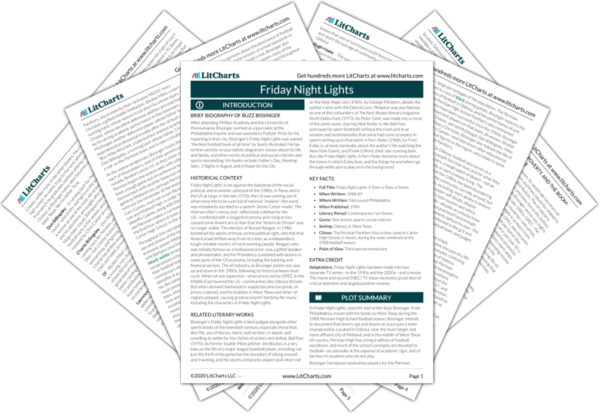In Friday Night Lights, reporter and writer Buzz Bissinger, from Philadelphia, moves with his family to West Texas during the 1988 Permian High School football season. Bissinger intends to document that team’s ups and downs as it pursues a state championship. Located in Odessa, near the much larger and more affluent city of Midland, and in the middle of West-Texas oil country, Permian High has a long tradition of football excellence, and much of the school’s energies are devoted to football—occasionally at the expense of academic rigor, and of fairness to students who do not play.
Bissinger introduces several key players for the Permian Panthers, also known by their nickname MOJO: Ivory Christian, a gifted middle linebacker; Boobie Miles, a mercurial running back, whose season is cut short by a knee injury; Brian Chavez, whose excellent defensive abilities are matched only by his strong academic performance in the classroom; Jerrod McDougal, another defensive player, whose father has experienced professional trouble after the oil bust of the late ‘80s; Mike Winchell, a talented but anxious quarterback; and Don Billingsley, a running back whose father, Charlie, was once a star on the Permian team, and is now a troubled alcoholic.

As the season progresses, Bissinger tracks the performance of each of these players, and of their parents and guardians (most notably, Boobie’s uncle LV), as they cheer on the Panthers. Permian begins the season well, with a blow-out victory, but loses a tough game out of conference to Marshall, only to bounce back with another blow-out win, only to lose a close game to Midland Lee, perhaps Permian’s closest rival. Permian wins out the remainder of the season, going 7-2, but its coach, Gary Gaines, must win a coin flip with the coaches of Midland Lee and Midland High, in order for Permian to make the playoffs. Gaines, along with the Midland Lee coach, win the flip, and Permian makes a run toward the state title, ultimately into the final four, where it loses a tough game to a Dallas school, Carter High School, in the state semifinals.
Throughout this narrative, Bissinger tells the twin story of the ups and downs of the town of Odessa: its rivalry with local economic power Midland, where George H. W. Bush and his wife Barbara once lived; its difficulties with issues of race (black-white tension) and segregation; the educational compromises school districts in Texas make in order to favor their football teams. By the end of the book, Bissinger’s commentary on football in Texas is mixed. Although he identifies it as a source of pride for many Texas communities, he, like some local politicians and advocates, fears that far too much pressure is placed on the shoulders of 17 and 18 year-old boys, who feel that, once football is gone in high school, their lives are over. Bissinger wonders whether it is healthy for societies to claim that, for some of its “chosen” players, life never gets better than their senior year in high school, and, also, whether it is healthy for the communities themselves that they place so much more emphasis on football as opposed to other things.







